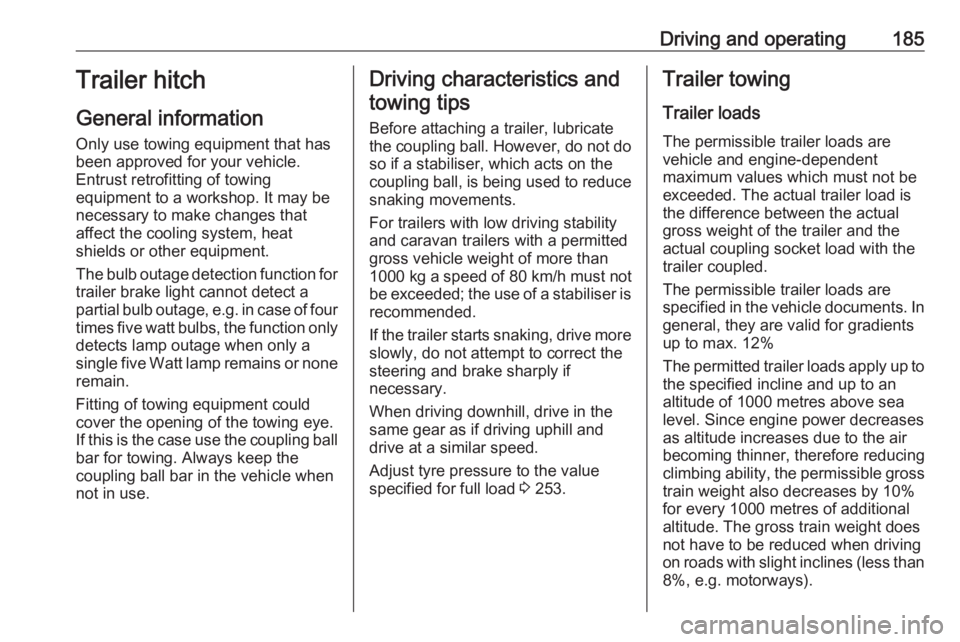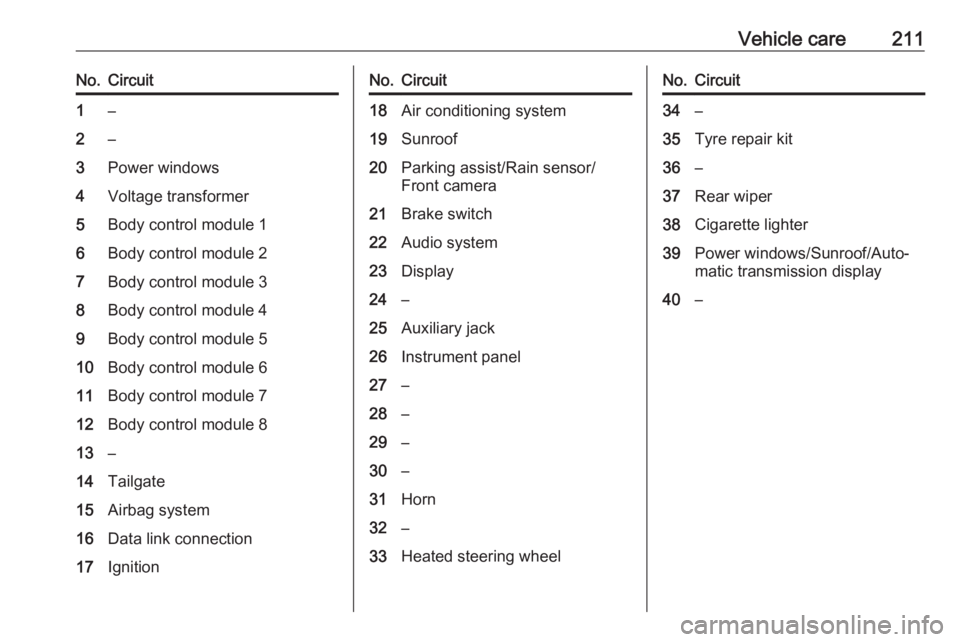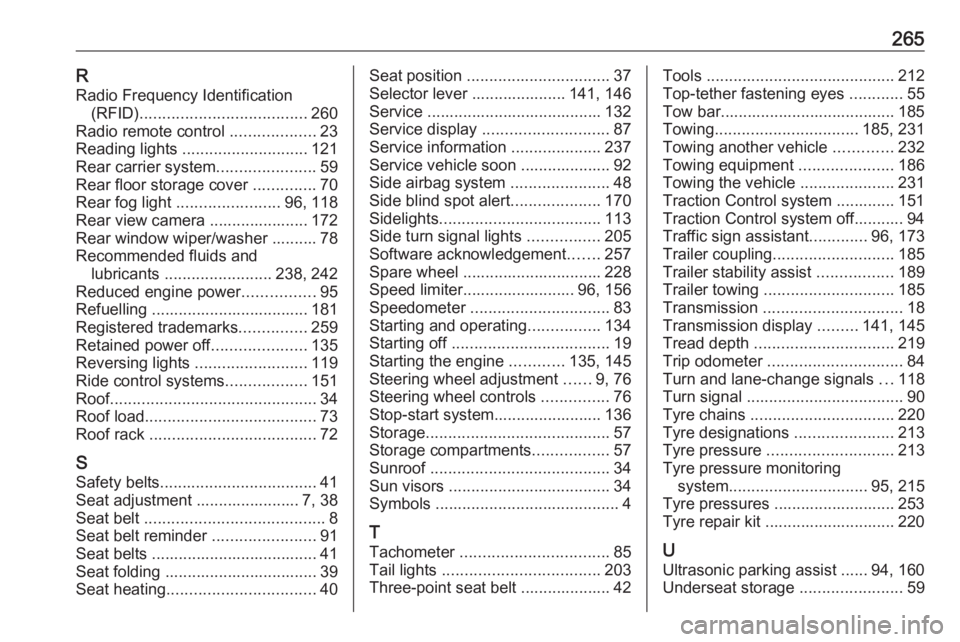steering OPEL CORSA E 2017.5 Manual user
[x] Cancel search | Manufacturer: OPEL, Model Year: 2017.5, Model line: CORSA E, Model: OPEL CORSA E 2017.5Pages: 269, PDF Size: 7.97 MB
Page 178 of 269

176Driving and operatingIn some cases, traffic sign assistant is
cleared up automatically by the
system.
Clearing of traffic signs
There are different scenarios that
lead to clearing the currently
displayed traffic signs. After clearing,
the “Default Sign” is displayed in the
Driver Information Centre.
Reasons for signs being cleared: ● A predefined distance was driven
or time has elapsed (differs for
each sign type)
● Vehicle drives through a turn
● The speed becomes slower than 52 km/h (city entry detection)
Fault
The traffic sign assistant system may
not operate correctly if:
● The area of the windscreen, where the front camera is
located, is not clean or affected
by foreign items, e.g. stickers.
● Traffic signs are completely or partially covered or difficult to
discern.● There are adverse environmental
conditions, e.g. heavy rain, snow,direct sunlight or shadows.
● Traffic signs are incorrectly mounted or damaged.
● Traffic signs do not comply with the Vienna Convention on traffic
signs (Wiener Übereinkommen
über Straßenverkehrszeichen).Caution
The system is intended to help the driver within a defined speed
range to discern certain traffic
signs. Do not ignore traffic signs
which are not displayed by the
system.
The system does not discern any other than the conventional traffic
signs that might give or end a
speed limit.
Do not let this special feature
tempt you into taking risks when
driving.
Always adapt speed to the road
conditions.
The driver assistance systems do not relieve the driver from full
responsibility for vehicle
operation.
Lane departure warning
The lane departure warning system
observes the lane markings between
which the vehicle is driving via a front camera. The system detects lane
changes and warns the driver in the
event of an unintended lane change
via visual and acoustic signals.
Criteria for the detection of an
unintended lane change are:
● No operation of turn signals.
● No brake pedal operation.
● No active accelerator operation or speeding-up.
● No active steering.
If the driver is performing these
actions, no warning will be issued.
Page 187 of 269

Driving and operating185Trailer hitch
General information
Only use towing equipment that has
been approved for your vehicle.
Entrust retrofitting of towing
equipment to a workshop. It may be
necessary to make changes that
affect the cooling system, heat
shields or other equipment.
The bulb outage detection function for trailer brake light cannot detect a
partial bulb outage, e.g. in case of four
times five watt bulbs, the function only detects lamp outage when only a
single five Watt lamp remains or none remain.
Fitting of towing equipment could
cover the opening of the towing eye.
If this is the case use the coupling ball
bar for towing. Always keep the
coupling ball bar in the vehicle when
not in use.Driving characteristics and
towing tips
Before attaching a trailer, lubricatethe coupling ball. However, do not do
so if a stabiliser, which acts on the coupling ball, is being used to reduce snaking movements.
For trailers with low driving stability
and caravan trailers with a permitted
gross vehicle weight of more than
1000 kg a speed of 80 km/h must not
be exceeded; the use of a stabiliser is
recommended.
If the trailer starts snaking, drive more slowly, do not attempt to correct the
steering and brake sharply if
necessary.
When driving downhill, drive in the
same gear as if driving uphill and
drive at a similar speed.
Adjust tyre pressure to the value
specified for full load 3 253.Trailer towing
Trailer loadsThe permissible trailer loads are
vehicle and engine-dependent
maximum values which must not be
exceeded. The actual trailer load is
the difference between the actual
gross weight of the trailer and the
actual coupling socket load with the
trailer coupled.
The permissible trailer loads are
specified in the vehicle documents. In general, they are valid for gradients
up to max. 12%
The permitted trailer loads apply up to the specified incline and up to an
altitude of 1000 metres above sea
level. Since engine power decreases
as altitude increases due to the air
becoming thinner, therefore reducing
climbing ability, the permissible gross
train weight also decreases by 10%
for every 1000 metres of additional
altitude. The gross train weight does
not have to be reduced when driving
on roads with slight inclines (less than
8%, e.g. motorways).
Page 191 of 269

Driving and operating1899Warning
Towing a trailer is permitted only
when a coupling ball bar is fitted correctly. If the coupling ball bardoes not engage correctly, seekthe assistance of a workshop.
Dismounting the coupling ball bar
Insert the key in the lock and unlock
the coupling ball bar.
Push the rotary knob onto the
coupling ball bar and rotate right while pressed down until it engages. Pull
out the ball bar downwards.
Insert sealing plug in opening for
coupling ball bar. Fold away socket.
Trailer stability assist
If the system detects snaking
movements, engine power is reduced
and the vehicle/trailer combination is
selectively braked until the snaking ceases. While system is working keep
steering wheel as still as possible.
Trailer stability assist is a function of
the Electronic Stability Control 3 152.
Page 213 of 269

Vehicle care211No.Circuit1–2–3Power windows4Voltage transformer5Body control module 16Body control module 27Body control module 38Body control module 49Body control module 510Body control module 611Body control module 712Body control module 813–14Tailgate15Airbag system16Data link connection17IgnitionNo.Circuit18Air conditioning system19Sunroof20Parking assist/Rain sensor/
Front camera21Brake switch22Audio system23Display24–25Auxiliary jack26Instrument panel27–28–29–30–31Horn32–33Heated steering wheelNo.Circuit34–35Tyre repair kit36–37Rear wiper38Cigarette lighter39Power windows/Sunroof/Auto‐
matic transmission display40–
Page 222 of 269

220Vehicle careIf the wheel covers and tyres used are
not factory approved, the tyres must
not have a rim protection ridge.
Wheel covers must not impair brake
cooling.9 Warning
Use of unsuitable tyres or wheel
covers could lead to sudden
pressure loss and thereby
accidents.
Steel wheels: When using locking
wheel nuts, do not attach wheel
covers.
Tyre chains
Tyre chains are only permitted on the
front wheels.
Always use fine mesh chains that add no more than 10 mm to the tyre tread
and the inboard sides (including chain lock).
9 Warning
Damage may lead to tyre blowout.
Tyre chains are permitted on tyres of
size 175/70 R14, 185/70 R14,
185/65 R15, 205/45 R17.
Tyre chains are permitted on tyres of
size 195/55 R16 with rims of size
16 x 6 and 16 x 6.5, the latter only in combination with limited steering
angle. Seek the assistance of a
workshop.
Tyre chains are not permitted on tyres of size 215/45 R17 and 215/40 R18.
The use of tyre chains is not permitted on the temporary spare wheel.
Tyre repair kit Minor damage to the tyre tread can be
repaired with the tyre repair kit.
Do not remove foreign bodies from
the tyres.
Tyre damage exceeding 4 mm or that is at the tyre's side wall near the rim
cannot be repaired with the tyre repair kit.9 Warning
Do not drive faster than 80 km/h.
Do not use for a lengthy period.
Steering and handling may be
affected.
Page 234 of 269

232Vehicle care
Screw in the towing eye as far as it will
go until it stops in a horizontal
position.
Attach a tow rope – or better still a tow
rod – to the towing eye.
The towing eye must only be used for towing and not for recovering the
vehicle.
Switch on ignition to release steering
wheel lock and to permit operation of
brake lights, horn and windscreen
wiper.
Transmission in neutral.
Caution
Drive slowly. Do not drive jerkily.
Excessive tractive force can
damage the vehicle.
When the engine is not running,
considerably more force is needed to
brake and steer.
To prevent the entry of exhaust gases from the towing vehicle, switch on the
air recirculation and close the
windows.
Vehicles with automatic transmission: the vehicle must be towed facing
forwards, not faster than 80 km/h nor further than 100 km. In all other cases
and when the transmission is
defective, the front axle must be
raised off the ground.
Vehicles with manual transmission
automated: the vehicle must only be
towed facing forwards with the front axle raised off the ground.
Seek the assistance of a workshop. After towing, unscrew the towing eye.
Insert cap at the top and engage
downwards.
Towing another vehicle
Insert a screwdriver in the slot at the
lower bend of the cap. Release the
cap by carefully moving the
screwdriver downwards.
The towing eye is stowed with the
vehicle tools 3 212.
Page 266 of 269

264Headlights................................... 113Headlights when driving abroad 115
Head restraint adjustment .............8
Head restraints ............................ 36
Heated mirrors ............................. 31
Heated rear window ..................... 33
Heated steering wheel .................76
Heated windscreen .......................34
Heating ........................................ 40
Heating and ventilation system . 123
High beam ........................... 96, 115
High beam assist ..................96, 116
Hill start assist ........................... 150
Horn ....................................... 15, 77
I
Identification plate .....................241
Ignition switch positions .............134
Immobiliser ............................ 29, 95
Indicators ...................................... 83
Inductive charging ........................82
Information displays...................... 97
Instrument cluster ........................83
Instrument panel fuse box .........210
Instrument panel illumination .....206
Instrument panel illumination control .................................... 119
Instrument panel overview ........... 10
Interior care ............................... 236
Interior lighting ............................ 119Interior lights ...................... 120, 206
Interior mirrors .............................. 31
Interruption of power supply ......143
Introduction .................................... 3
ISOFIX child restraint systems ....55
J
Jump starting ............................. 230
K Key, memorised settings ..............24
Keys ............................................. 22
Keys, locks ................................... 22
L
Lane departure warning .......93, 176
Lashing eyes ............................... 71
Light switch ................................ 113
Load compartment ................27, 67
Load compartment cover .............69
Loading information .....................73
Low fuel ....................................... 95
M
Malfunction indicator light ............92
Manual anti-dazzle ......................31
Manual mode .....................142, 148
Manual transmission .................. 144
Manual transmission automated 145
Manual windows ..........................32
Memorised settings ......................24Mirror adjustment ........................... 8
Misted light covers .....................119
N
New vehicle running-in ..............134
Number plate light .....................206
O Object detection systems ...........160
Odometer ..................................... 84 Oil, engine .......................... 238, 242
OnStar ........................................ 109
Operate pedal ............................... 93
Outside temperature ....................79
Overrun cut-off ........................... 136
P Parking ................................ 20, 139
Parking assist ............................ 160
Parking brake ............................ 150
Parking lights ............................. 119
Particulate filter ........................... 140
Performance .............................. 247
Performing work ........................192
Pollen filter ................................. 131
Power outlets ............................... 82
Power steering.............................. 93
Power windows ............................ 32
Preheating ................................... 94
Puncture ..................................... 225
Page 267 of 269

265RRadio Frequency Identification (RFID) ..................................... 260
Radio remote control ...................23
Reading lights ............................ 121
Rear carrier system ......................59
Rear floor storage cover ..............70
Rear fog light ....................... 96, 118
Rear view camera ...................... 172
Rear window wiper/washer .......... 78
Recommended fluids and lubricants ........................ 238, 242
Reduced engine power ................95
Refuelling ................................... 181
Registered trademarks ...............259
Retained power off .....................135
Reversing lights .........................119
Ride control systems ..................151
Roof .............................................. 34
Roof load ...................................... 73
Roof rack ..................................... 72
S Safety belts ................................... 41
Seat adjustment ....................... 7, 38 Seat belt ........................................ 8
Seat belt reminder .......................91
Seat belts ..................................... 41 Seat folding .................................. 39
Seat heating ................................. 40Seat position ................................ 37
Selector lever ..................... 141, 146
Service ....................................... 132
Service display ............................ 87
Service information ....................237
Service vehicle soon .................... 92
Side airbag system ......................48
Side blind spot alert ....................170
Sidelights .................................... 113
Side turn signal lights ................205
Software acknowledgement .......257
Spare wheel ............................... 228
Speed limiter......................... 96, 156
Speedometer ............................... 83
Starting and operating ................134
Starting off ................................... 19
Starting the engine ............135, 145
Steering wheel adjustment ......9, 76
Steering wheel controls ...............76
Stop-start system........................ 136
Storage ......................................... 57
Storage compartments .................57
Sunroof ........................................ 34
Sun visors .................................... 34
Symbols ......................................... 4
T
Tachometer ................................. 85
Tail lights ................................... 203
Three-point seat belt .................... 42Tools .......................................... 212
Top-tether fastening eyes ............55
Tow bar....................................... 185
Towing ................................ 185, 231
Towing another vehicle .............232
Towing equipment .....................186
Towing the vehicle .....................231
Traction Control system ............. 151
Traction Control system off........... 94
Traffic sign assistant .............96, 173
Trailer coupling ........................... 185
Trailer stability assist .................189
Trailer towing ............................. 185
Transmission ............................... 18
Transmission display .........141, 145
Tread depth ............................... 219
Trip odometer .............................. 84
Turn and lane-change signals ...118
Turn signal ................................... 90
Tyre chains ................................ 220
Tyre designations ......................213
Tyre pressure ............................ 213
Tyre pressure monitoring system ............................... 95, 215
Tyre pressures ........................... 253
Tyre repair kit ............................. 220
U Ultrasonic parking assist ...... 94, 160
Underseat storage .......................59